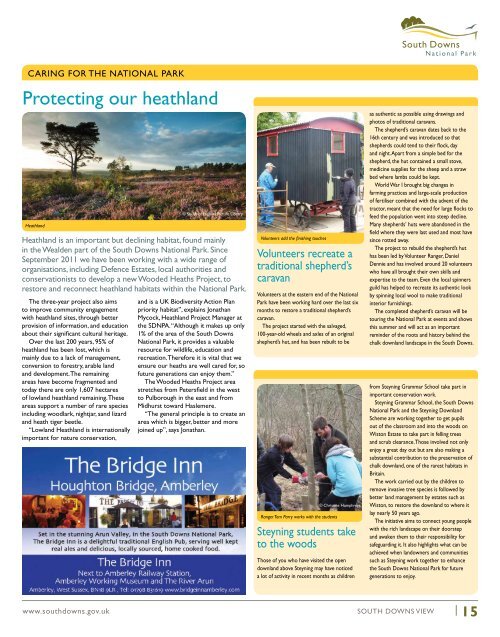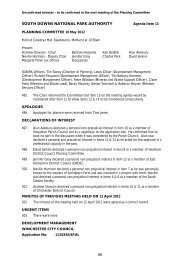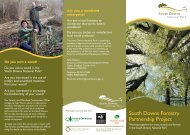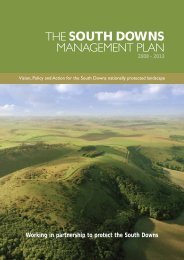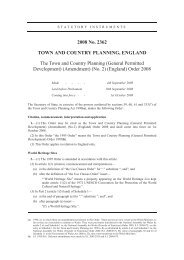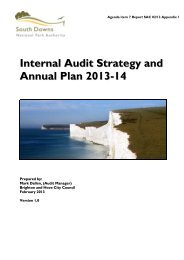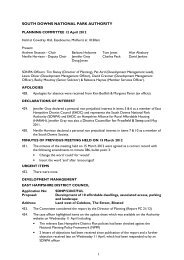South Downs View - South Downs National Park Authority
South Downs View - South Downs National Park Authority
South Downs View - South Downs National Park Authority
- No tags were found...
Create successful ePaper yourself
Turn your PDF publications into a flip-book with our unique Google optimized e-Paper software.
caring for the national parkProtecting our heathlandHeathlandHeathland is an important but declining habitat, found mainlyin the Wealden part of the <strong>South</strong> <strong>Downs</strong> <strong>National</strong> <strong>Park</strong>. SinceSeptember 2011 we have been working with a wide range oforganisations, including Defence Estates, local authorities andconservationists to develop a new Wooded Heaths Project, torestore and reconnect heathland habitats within the <strong>National</strong> <strong>Park</strong>.The three-year project also aimsto improve community engagementwith heathland sites, through betterprovision of information, and educationabout their significant cultural heritage.Over the last 200 years, 95% ofheathland has been lost, which ismainly due to a lack of management,conversion to forestry, arable landand development. The remainingareas have become fragmented andtoday there are only 1,607 hectaresof lowland heathland remaining. Theseareas support a number of rare speciesincluding woodlark, nightjar, sand lizardand heath tiger beetle.“Lowland Heathland is internationallyimportant for nature conservation,© <strong>South</strong> of England Picture Libraryand is a UK Biodiversity Action Planpriority habitat”, explains JonathanMycock, Heathland Project Manager atthe SDNPA. “Although it makes up only1% of the area of the <strong>South</strong> <strong>Downs</strong><strong>National</strong> <strong>Park</strong>, it provides a valuableresource for wildlife, education andrecreation. Therefore it is vital that weensure our heaths are well cared for, sofuture generations can enjoy them.”The Wooded Heaths Project areastretches from Petersfield in the westto Pulborough in the east and fromMidhurst toward Haslemere.“The general principle is to create anarea which is bigger, better and morejoined up”, says Jonathan.Volunteers add the finishing touchesVolunteers recreate atraditional shepherd’scaravanVolunteers at the eastern end of the <strong>National</strong><strong>Park</strong> have been working hard over the last sixmonths to restore a traditional shepherd’scaravan.The project started with the salvaged,100-year-old wheels and axles of an originalshepherd’s hut, and has been rebuilt to beRanger Tom Parry works with the students© Christine HumphreysSteyning students taketo the woodsThose of you who have visited the opendownland above Steyning may have noticeda lot of activity in recent months as childrenas authentic as possible using drawings andphotos of traditional caravans.The shepherd’s caravan dates back to the16th century and was introduced so thatshepherds could tend to their flock, dayand night. Apart from a simple bed for theshepherd, the hut contained a small stove,medicine supplies for the sheep and a strawbed where lambs could be kept.World War I brought big changes infarming practices and large-scale productionof fertiliser combined with the advent of thetractor, meant that the need for large flocks tofeed the population went into steep decline.Many shepherds’ huts were abandoned in thefield where they were last used and most havesince rotted away.The project to rebuild the shepherd’s huthas been led by Volunteer Ranger, DanielDennie and has involved around 20 volunteerswho have all brought their own skills andexpertise to the team. Even the local spinnersguild has helped to recreate its authentic lookby spinning local wool to make traditionalinterior furnishings.The completed shepherd’s caravan will betouring the <strong>National</strong> <strong>Park</strong> at events and showsthis summer and will act as an importantreminder of the roots and history behind thechalk downland landscape in the <strong>South</strong> <strong>Downs</strong>.from Steyning Grammar School take part inimportant conservation work.Steyning Grammar School, the <strong>South</strong> <strong>Downs</strong><strong>National</strong> <strong>Park</strong> and the Steyning DownlandScheme are working together to get pupilsout of the classroom and into the woods onWiston Estate to take part in felling treesand scrub clearance. Those involved not onlyenjoy a great day out but are also making asubstantial contribution to the preservation ofchalk downland, one of the rarest habitats inBritain.The work carried out by the children toremove invasive tree species is followed bybetter land management by estates such asWiston, to restore the downland to where itlay nearly 50 years ago.The initiative aims to connect young peoplewith the rich landscape on their doorstepand awaken them to their responsibility forsafeguarding it. It also highlights what can beachieved when landowners and communitiessuch as Steyning work together to enhancethe <strong>South</strong> <strong>Downs</strong> <strong>National</strong> <strong>Park</strong> for futuregenerations to enjoy.www.southdowns.gov.uk south downs <strong>View</strong> 15


